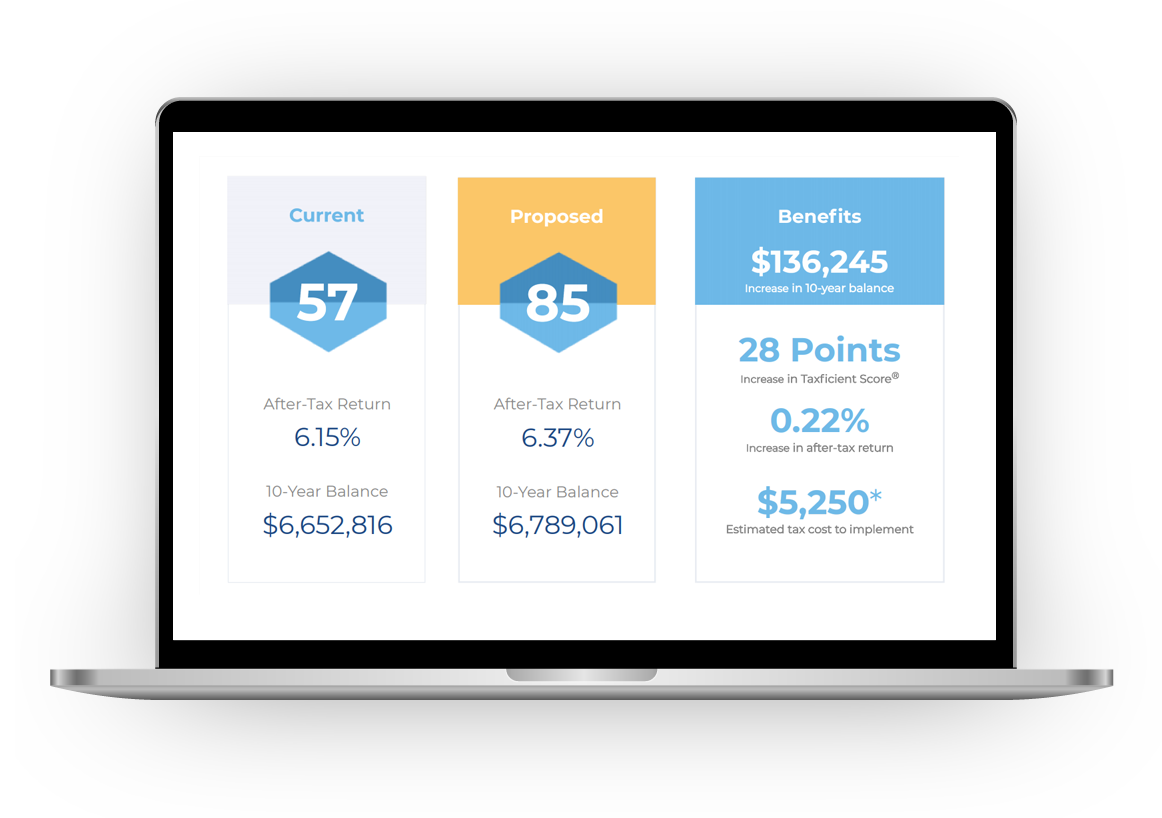Tax-Efficient Investing At Scale
Clients who visit your firm looking for investment help are looking for the most tax-efficient strategy, even if they don’t know that is what they need.
As an advisor, the goal is to optimize a client’s household portfolio by strategically coordinating assets across various accounts in the most tax-efficient manner. The traditional approach of managing each account in isolation is no longer in the client’s best interest, and this is widely recognized. However, to achieve this effectively, advisors and firms require technology that enables them to manage a client’s portfolio as a unified managed household, rather than focusing solely on individual accounts.
SEI LifeYield technology was created to help financial firms create a more unified and tax-efficient investing strategy for their clients.

Explaining Tax Efficient Investing
Taxes can have a significant impact on investment returns. When investors buy, sell, or hold investments, they may trigger taxable events that result in capital gains or losses. Additionally, certain investment income, such as dividends or interest, is typically subject to taxation. These taxes can reduce the overall returns and potentially erode the growth of the investment over time.
There are strategies and technologies available to help minimize the impact of taxes on investment returns. SEI LifeYield, for example, aims to facilitate tax-efficient investing for advisors and their clients. SEI LifeYield offers tools and solutions designed to optimize the tax efficiency of a client’s household portfolio while maximizing their retirement income.
SEI LifeYield technology helps advisors analyze and manage their clients’ investments holistically, taking into account factors such as tax brackets, capital gains, and losses. By considering the overall tax implications of various investment decisions, SEI LifeYield can help advisors make informed choices that minimize tax drag and maximize after-tax returns for their clients.
Types of Investment Accounts
Taxable Accounts
Taxable accounts are investment accounts that do not have as many tax benefits or restrictions compared to tax-advantaged accounts. In these accounts, the investments held by your clients fall into different tax brackets depending on the duration they are held. If your client holds investments in these accounts for longer than a year, they may qualify for more favorable tax rates on capital gains. Currently, the long-term capital gains tax rates range from 0% to 20%, depending on the client’s income tax bracket.
Tax-Advantaged Accounts
Tax-advantaged accounts, on the other hand, provide certain tax benefits and fall into two categories: tax-deferred and tax-exempt accounts.
Tax-Deferred Accounts
These accounts, such as traditional Individual Retirement Accounts (IRAs) or 401(k) accounts, offer a tax-deferred status. This means that the taxes on contributions made to these accounts are postponed until the client withdraws the money during retirement. Contributions to these accounts may be tax-deductible, reducing the client’s taxable income in the year of contribution. However, when the funds are eventually withdrawn, they are subject to income tax at the client’s then-applicable tax rate.
Tax-Exempt Accounts
Tax-exempt accounts, such as Roth IRAs or Roth 401(k) accounts, are initially taxed. Contributions made to these accounts are not tax-deductible, but the growth and withdrawals can be tax-free if certain conditions are met. This means that when the client withdraws money from these accounts in retirement, they are generally exempt from income tax, as long as the account has been open for at least five years and the client meets other qualifying criteria.
Constraints on Tax-Advantaged Accounts
Tax-advantaged accounts have specific constraints set by the government to maintain their tax benefits. These constraints determine contribution limits and rules regarding when and how the money can be withdrawn.
For example, traditional IRAs and 401(k) accounts have contribution limits set by the Internal Revenue Service (IRS). Contributions to these accounts may be subject to annual limits based on factors such as the client’s age and income level. Withdrawals from these accounts before reaching a certain age (generally 59½) may result in early withdrawal penalties and taxes.
Roth IRAs and Roth 401(k) accounts also have contribution limits, but contributions are not tax-deductible. These accounts have different rules for withdrawals, allowing clients to potentially access their contributions (not the earnings) penalty-free before retirement. However, to enjoy tax-free withdrawals of both contributions and earnings, specific criteria must be met.
Understanding the types of investment accounts, including taxable and tax-advantaged accounts, is crucial for optimizing tax efficiency in investing. By strategically utilizing the benefits and constraints of each account type, along with technologies like those available from SEI LifeYield, advisors can help minimize the tax drag on their clients’ investment returns and maximize their long-term retirement income.
Possible Ways Clients Can Distribute Investment Money
| Taxable Accounts (ex. Brokerage) | Tax-Advantaged Accounts (ex. IRAs) |
|---|---|
| Individual stocks held for at least a year | Individual stocks held for less than a year |
| Tax-managed stock funds, index funds, ETFs | Managed stock funds that generate short-term gains |
| Qualified dividend-paying stocks/mutual funds | Taxable bond funds, inflation-protected bonds, high-yield bond funds |
| Series I bonds, municipal bond funds | Real estate investments trusts (REITs) |
Asset Allocation: An Essential Component of Tax-Efficient Investing
Asset allocation plays a critical role in developing a tax-efficient investing strategy. Asset allocation is the process of determining the optimal allocation of different asset categories within a portfolio. This allocation typically includes a mix of stocks, bonds, cash, and other investment options based on the client’s risk tolerance, investment goals, and time horizon.
When working with new investment clients, one of the advisor’s initial steps is to create an appropriate asset allocation. This involves assessing the client’s financial situation, risk tolerance, and investment objectives. By carefully considering these factors, advisors can design a diversified portfolio that aims to maximize returns while managing risk.
The goal of asset allocation is to create a well-balanced portfolio that can weather market fluctuations and potentially generate consistent returns over the long term. However, asset allocation alone does not fully address the tax implications of investments.
Asset Location: Optimizing Tax Efficiency in a Portfolio
While asset allocation focuses on determining the appropriate mix of assets, asset location takes it a step further by determining where those assets should be held within the investment portfolio. Asset location involves considering the different tax implications associated with holding investments in taxable and tax-advantaged accounts.
Taxable accounts are subject to annual taxation on dividends, capital gains, and interest income. On the other hand, tax-advantaged accounts, such as traditional IRAs or 401(k) accounts, offer tax benefits like tax-deferred growth or tax-exempt withdrawals.
To optimize tax efficiency, advisors must carefully consider the tax implications of each investment and determine the most appropriate account for its placement. This decision involves strategically placing investments that generate higher taxable income, such as bonds or actively traded funds, into tax-advantaged accounts. Meanwhile, investments with lower taxable income, such as stocks with qualified dividends, may be held in taxable accounts.
By considering asset location, advisors aim to minimize the tax drag on their client’s investment returns. This approach can enhance after-tax returns and maximize the growth of the portfolio over time.
The Interplay Between Asset Allocation and Asset Location
While asset allocation and asset location have distinct purposes, they are interconnected and complement each other in building a tax-efficient portfolio.
Asset allocation focuses on finding the right mix of investments based on the client’s goals and risk tolerance. It determines the proportions of stocks, bonds, and other asset classes within the portfolio. Once the asset allocation is established, asset location comes into play, determining the most suitable account type for each investment.
Together, asset allocation and asset location work harmoniously to create a tax-efficient investing strategy. By considering both aspects, advisors can help optimize the tax consequences of their client’s investments, aiming to minimize tax drag and maximize after-tax returns.
With technologies like SEI LifeYield, advisors can leverage tools and solutions that assist in analyzing the tax implications of different asset locations. These technologies help advisors make informed decisions when placing investments in taxable and tax-advantaged accounts, ultimately contributing to the overall tax efficiency of the client’s portfolio.

How SEI LifeYield Changes Tax Efficient Investment Strategies
Tax-efficient investment strategies were once only applied to one account at a time. Even the software that managed tax efficiency for these accounts before SEI LifeYield only worked on individual accounts. SEI LifeYield can work with one or several accounts to enable a unified managed household for each client. Large tax bills are an issue facing investors holding assets in multiple accounts both tax-advantaged and taxable accounts.
What does a unified managed household have to do with investing? All the investment accounts of a client and their immediate family should be considered a household. The household-level approach, when looked at as one entity, is a holistic way of managing assets that result in more retirement income for the client, and ultimately, more revenue for the advisor and firm. Looking at the entire array of accounts in a household is the best way to create a tax-efficient investment strategy. This is because all the accounts and the tax implications are viewed at full scale. The term for this modern investment strategy is “unified managed household”.
Using the SEI LifeYield Technology Library to Increase Tax-Efficient Investments
SEI LifeYield changes the way firms and advisors approach client portfolios. Beginning with the location of assets, SEI LifeYield technology looks for all opportunities to improve tax efficiency. When it comes to the household portfolio, SEI LifeYield identifies the optimal location for every asset, then offers the next best actions for reducing tax drag and quantifies those benefits in dollars.
SEI LifeYield’s proprietary algorithm looks at all the accounts within a household and makes asset location recommendations regardless of account type. Once assets are efficiently located across accounts, the technology can then recommend various scenarios for making tax-smart withdrawals, harvesting gains and losses, and rebalancing efficiently as needed.
Tax-Smart Withdrawals
In order to recommend tax-smart withdrawals to a household, advisors used to have to manually look through each account owned by a household member and calculate the tax burden of the withdrawal. There was no way for them to look at the accounts as a whole, only individually. There was also no way of running multiple scenarios at one time to determine which provided the most favorable outcome.
Going further with this, advisors could not efficiently look at the repercussions of the withdrawal and the rebalancing required for the portfolio before executing it. Rebalancing can be complicated, especially if trying to ensure that the tax efficiency remains maximized across the entire household. Rebalancing can be completed extremely easily (if it’s even needed at all) after taking tax-smart withdrawals as directed by the SEI LifeYield technology.
When identifying how to make tax-smart withdrawals, SEI LifeYield can optionally manage the withdrawal process using a proprietary “tax-aware” lot selection method that will consider the entire household portfolio. With SEI LifeYield technology, it is possible to incorporate a more integrated, tax-intelligent process during the withdrawal instead of having to perform an additional rebalance step after every withdrawal scenario.
Tax-Harvesting
Another strategy for tax-efficient investing is tax harvesting. The most common tax harvesting scenario is loss harvesting, where an investor sells securities at a loss to offset other capital gains. On the other hand, gain-harvesting is used to identify the optimal tax lots for gifting or charitable donations.
SEI LifeYield Tax Harvesting works with our asset location, rebalancing, and tax-smart withdrawal engines to scan the entire portfolio’s household and find the opportunities available to reduce the tax burden.
SEI LifeYield can work both ways when looking for tax-harvesting opportunities, even though most clients are looking for losses that can offset gains in a tax situation. The tax-harvesting capability looks at all taxable and non-taxable accounts, which is important when searching for opportunities to harvest gains or losses and simultaneously avoiding wash sales.
Putting All the Parts Together
Your client’s portfolio and tax-efficient investing strategy are all like a big machine. At least, that is how it should be viewed. Overall, you want the machine to be an efficient piece of equipment that serves a purpose and doesn’t break down along the way. The goal of investing is to have as much income as possible through retirement, supplementing the Social Security benefits and pension income your client may receive in the future.
Your firm’s actions are like the mechanic who keeps the machine running efficiently until it reaches its destination. You do this by allocating and locating your client’s assets, creating tax-efficient withdrawals, and determining the opportunities that will mean the most now and in the future.
Not All Taxes Were Created Equal
When it comes to taxes, not all aspects are considered by popular tax software programs like TurboTax or H&R Block. While these tools assist in determining overall tax liability and can handle general tax-related matters, they do not specifically address investment tax efficiency. This is where SEI LifeYield technology comes in.
SEI LifeYield aims to provide advisors with the tools to create a fully tax-efficient experience for clients, from investment through withdrawal, to accumulation through decumulation. By coordinating assets across various accounts and leveraging the tax benefits of each account when rebalancing and taking withdrawals, SEI LifeYield technology helps minimize a client’s investment taxes.
Income Taxes and Short-Term Capital Gains
Taxes are typically levied at two different rates: income tax and long-term capital gains rates. Short-term capital gains refer to investments held for less than a year and are taxed at a client’s ordinary income tax rate. Tax brackets undergo annual changes by the IRS. Depending on your client’s total annual income, sales or withdrawals that are not made with an eye toward the tax consequences may result in a client paying more in taxes than they bargained for.
Long-Term Capital Gains
On the other hand, long-term capital gains apply to investments held for more than a year. They are subject to a specific tax rate based on the client’s tax bracket and overall income for the relevant tax year. Individual tax brackets have tax rates of 0%, 15%, and 20%, which are determined by the client’s income for the year.
Some clients can use long-term capital gains to maximize their investments for retirement by doing what’s called a Roth IRA conversion. If there is sufficient room within their income bracket, they may have the opportunity to sell an investment and roll the proceeds into a Roth IRA. By doing so, they can take advantage of the lower tax rate for long-term gains and move the income to a tax-exempt investment account.
Example
Let’s use an example to illustrate this concept using the SEI LifeYield Tax Calculator.
Suppose your 52 year old client has a total yearly income (salary) of $250,000. They unexpectedly incur a $30,000 bill and plan to make a withdrawal from a taxable, long-term investment account to cover it. At this point, their total income for the year reaches $280,000. According to the SEI LifeYield Tax Calculator, the client would pay 15% on the long-term gains on the $30,000 withdrawal.
By strategically planning these withdrawals and conversions, clients can potentially optimize their tax efficiency and make the most of their investments.
SEI LifeYield technology can help advisors identify these opportunities and guide clients through the process, ensuring that they take full advantage of available tax benefits and minimize unnecessary tax burdens on their investment returns.

The Benefits of Switching to SEI LifeYield Household-Level Management Technology
By implementing SEI LifeYield to analyze clients’ portfolios at the household level, significant benefits can be found for both clients and advisors. With SEI LifeYield, your firm and advisors can optimize tax efficiency across the board for every client’s portfolio instantly, resulting in more revenue for your firm. Some of the main benefits of SEI LifeYield Tax-Efficiency APIs are:
The main benefits of SEI LifeYield Tax-Efficiency APIs are:
- Increase Advisor Efficiency: One of your firm’s goals should be to have the most efficient advisors within the financial advice market. Using technology like SEI LifeYield helps make your advisors more efficient in every aspect of their financial planning, saves them time, and improves tax efficiency across all household portfolios.
- Improve Outcomes for Clients: As a firm that controls portfolios and retirement outcomes for clients, shouldn’t you want to ensure that investors maximize their returns from their investments? Traditional methods of achieving tax efficiency and exploring individual accounts have proven to be less than ideal for investors. These methods often left room for small mistakes and failed to consider all the pertinent data. SEI LifeYield addresses these issues by automating the entire process, guaranteeing accuracy every time.
- Create a Superior Experience for the Advisor and the Client: In the past, advisors faced challenges when explaining complex concepts to investors, lacking the tools to quantify the impact of their actions. With SEI LifeYield, advisors now have access to a comprehensive view of all accounts within a household, equipped with reliable technology that precisely demonstrates how clients can enhance their overall financial outcomes. This fosters trust and transparency between the client and advisor by simplifying discussions around tax-efficient investing, making them more accessible and understandable.
As advisors and financial firms, the fiduciary duty that you are required to uphold includes placing assets in the most tax-advantaged accounts for the client. The best way to achieve this is by using SEI LifeYield technology to accommodate all possible scenarios that your client’s accounts might encounter. Not all client accounts are going to fall under the same rules. Knowing all the required information takes more time than it’s worth to your advisors. SEI LifeYield knows that these accounts are different, incorporates all up-to-date and relevant information, and always supports execution at the household level.

Increase Tax Efficient Investing with SEI LifeYield
If you need a solution for improving the tax efficiency of your client’s investment portfolio, look no further than SEI LifeYield. Our technology changes the way firms manage accounts and is the only way to obtain the holy grail of a Unified Managed Household.
With so many tax rules and investment account treatments, it’s nearly impossible to manage a complex multi-account portfolio in the most efficient way. SEI LifeYield takes the error out of the equation. Now, your firm can optimize tax efficiency for every household, make tax-smart withdrawals, harvest losses, harvest gains, and make the best decisions possible for each client. All of this and more is accommodated with the SEI LifeYield software.
For educational purposes only. This information should not be considered investment advice.
